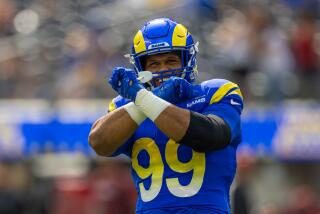Sammy Baugh dies at 94; NFL star led Washington Redskins to 2 titles
Slingin’ Sammy Baugh, a record-setting passer, punter and defensive back who led the Washington Redskins to two National Football League championships in 16 seasons and whose wide-open style of play helped usher professional football into the modern era, died Dec. 17 at Fisher County Memorial Hospital in Rotan, Texas. He was 94.
Baugh, a charter member of the NFL Hall of Fame, had lived for the last few years at a nursing home in the small West Texas town of Jayton, about 30 miles from his beloved Double Mountain Ranch. His daughter-in-law, Jean Baugh, said he died of kidney failure and pneumonia. Doctors told her his body just wore out.
Sportswriter Dan Jenkins, who saw Baugh play at Texas Christian University and with the Washington Redskins, called him “the greatest quarterback who ever lived, college or pro.”
Baugh, a tall, rangy Texan, was a superb all-around athlete -- he signed a professional baseball contract with the St. Louis Cardinals the summer before joining the Redskins. As a rookie, Baugh led the team to its first division title and an opportunity to play the Chicago Bears, the fearsome Monsters of the Midway, for the NFL championship.
During 16 seasons with the Redskins, Baugh would direct the team to four divisional titles and a second NFL championship in 1942. He retired after the 1952 season as a popular icon of football excellence.
For most of his career in Washington, he played both defense and offense as well as on special teams. But he was always best known as a pinpoint passer who could hit his receivers over long and short distances while under extreme defensive pressure. For six seasons -- 1937, 1940, 1943, 1945, 1947 and 1949 -- he led the NFL in passing. Twice he threw six touchdown passes in a single game. His career totals were more than 1,700 completed passes, 187 for touchdowns.
He also was a superb punter, the last master of the all-but-forgotten stratagem of the quick kick, and a formidable defensive back. Against the run, he was a fierce tackler who could bring down the fabled fullback Bronko Nagurski. Defending against the pass, he was an interception threat. He had 28 over his career. In one season, 1943, he led the NFL in passing, in punting and in interceptions with 11. He’s the only player ever to lead the league in offensive, defensive and special teams categories.
Baugh led the Redskins to a second NFL championship with a 14-6 victory over the Chicago Bears in 1942, coming from behind after the Bears scored first on a 50-yard runback of a recovered Redskins fumble. In that contest, Baugh stunned the Bears with an 85-yard quick kick on a third-down play, tossed a 25-yard touchdown pass to halfback Wilbur Moore and orchestrated an 80-yard drive for the final score that ended when Andy Farkas ran the ball into the end zone from the 1-yard line.
That game was sweet revenge for a 73-0 humiliation of the Redskins by the Bears in the 1940 NFL championship game. Playing at Griffith Stadium in Washington, 10 different Bears players scored 11 touchdowns. The Redskins, who had defeated the Bears 7-3 on the same field three weeks earlier, botched a scoring opportunity early in the game when the usually reliable receiver Charlie Malone dropped a Baugh pass on the goal line. At the time, the Bears had scored only seven points, and the outcome of the game was still in doubt.
Someone later asked Baugh if the result would have been different had Malone not dropped the pass.
“Sure,” Baugh said. “The final score would have been 73-6.”
Samuel Adrian Baugh was born in Temple, Texas, and moved to Sweetwater in high school. He played four years of high school football, but his main sport was baseball, and he was recruited to play third base at Texas Christian. He did, but he also joined the football team, and was an All-American as TCU won the 1935 national championship and the Sugar Bowl and the Cotton Bowl. In 1935, he also was the star of the College All-Star Game, which was sponsored by the Chicago Tribune, throwing a touchdown pass to beat the Green Bay Packers, 6-0.
In Washington, his greatest success came during his early years. Baugh’s last winning season came in 1948, when the Redskins had a 7-5 record. He took the team to its fourth Eastern Division title in 1945, the last one of his career.
During his final year with the Redskins, Baugh injured his hand in the fourth game of the season, and was unable to grip the football for a month. He saw only limited action thereafter. In December 1952, he retired.
For five years after leaving the Redskins, Baugh coached football at Hardin-Simmons College in Texas, compiling a won-lost record of 23-28. He also was a coach of freshman football at Oklahoma State University, a backfield coach at the University of Tulsa and head coach for two years of the New York Titans, later the New York Jets, of the fledgling American Football League.
He was head coach of the Houston Oilers in 1964 and had a record of four wins and 10 losses. But the job interfered with his West Texas cattle operations, and he left to return to his 6,300-acre ranch near Rotan.
In 1938, Baugh married his college sweetheart, Edmonia Smith, in Sweetwater. She died in 1990.
Survivors include four children, Tod Baugh of Billings, Mont., David Baugh of Rotan, Stephen Baugh of Midland, Texas, and Frances White of Lubbock, Texas; 11 grandchildren; and 12 great-grandchildren.
Holley and Barnes write for the Washington Post.
More to Read
Start your day right
Sign up for Essential California for the L.A. Times biggest news, features and recommendations in your inbox six days a week.
You may occasionally receive promotional content from the Los Angeles Times.






